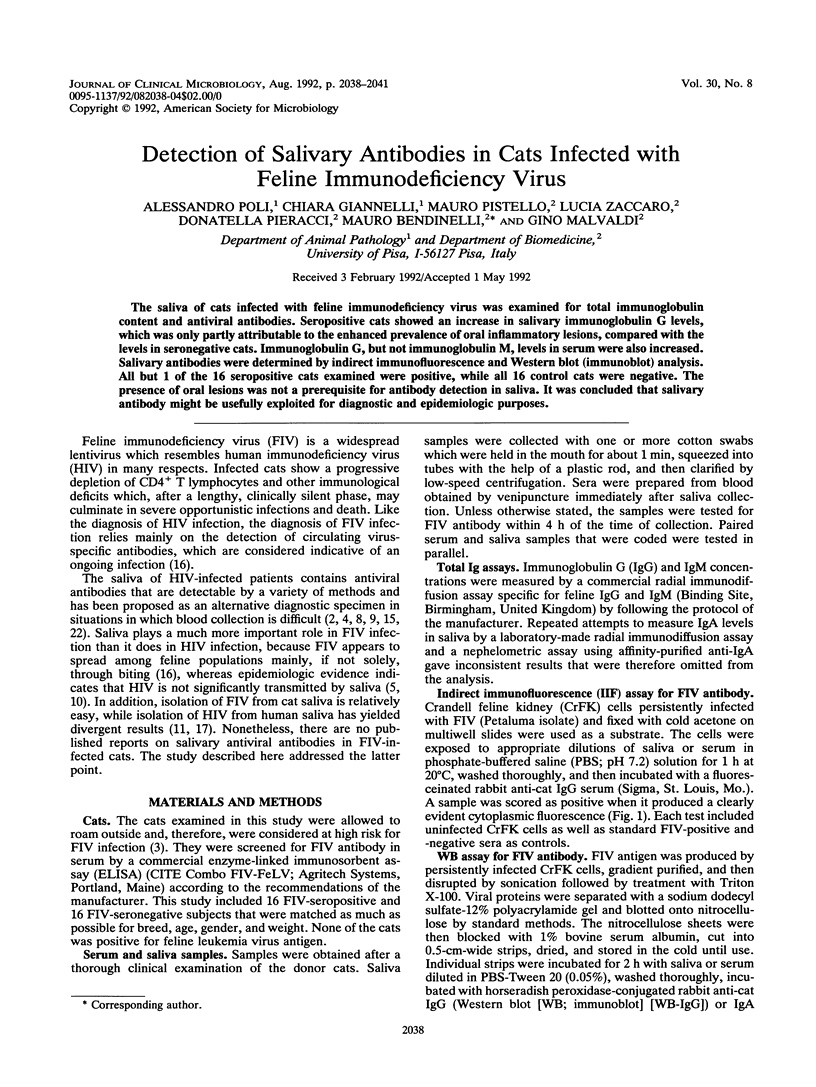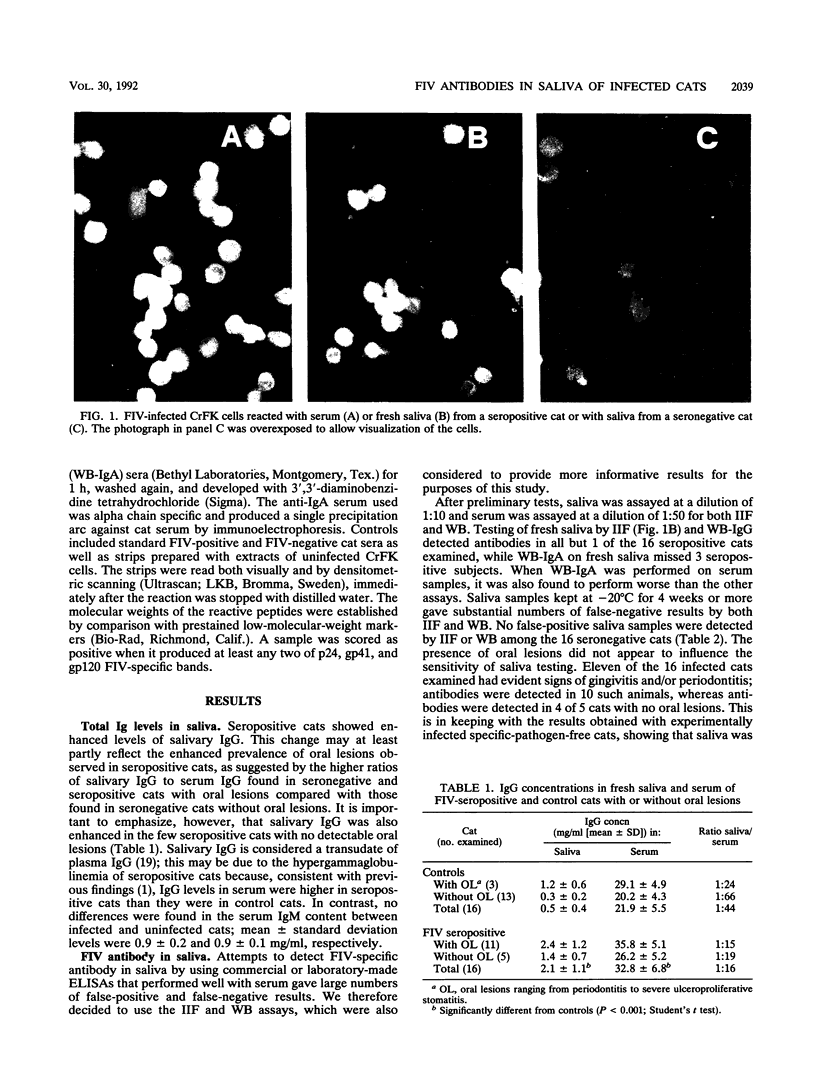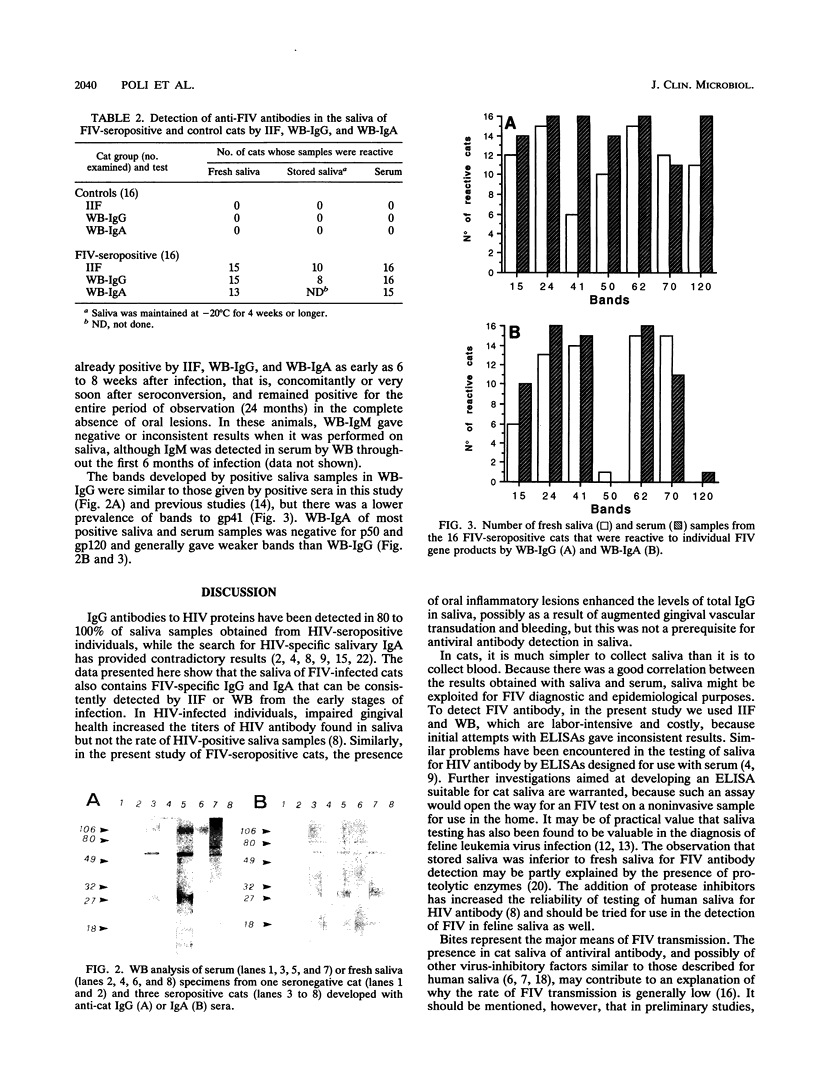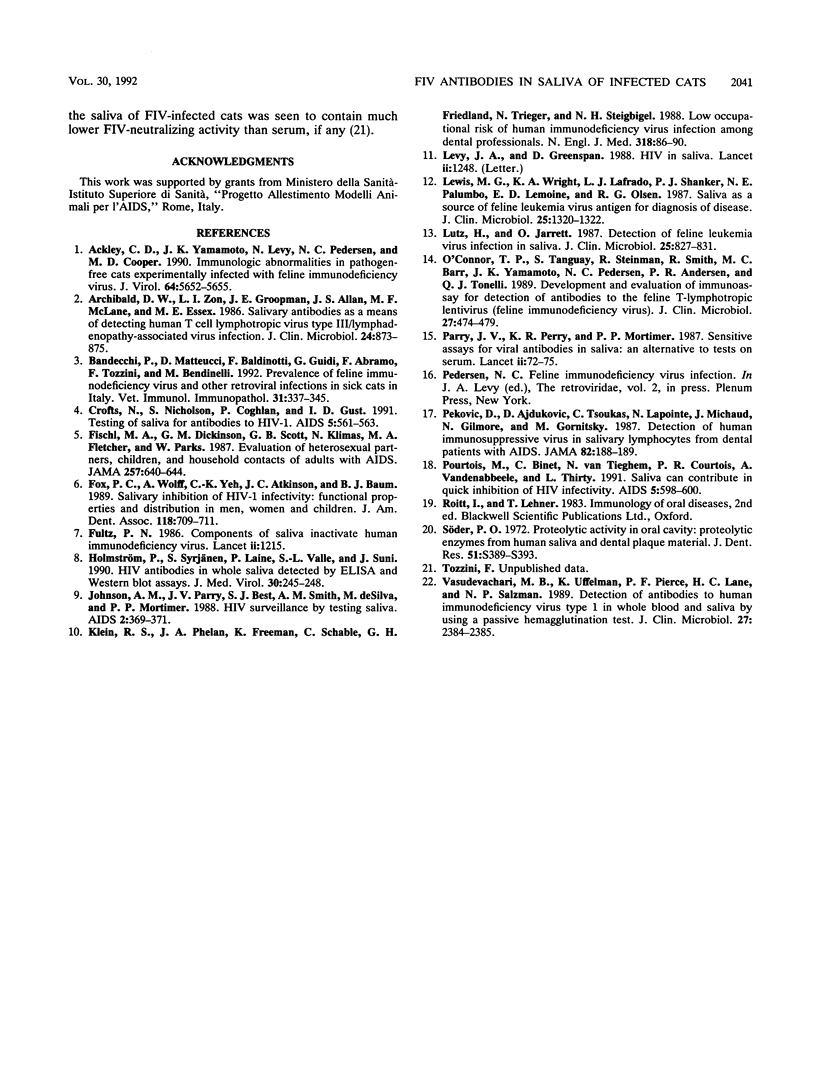Abstract
The saliva of cats infected with feline immunodeficiency virus was examined for total immunoglobulin content and antiviral antibodies. Seropositive cats showed an increase in salivary immunoglobulin G levels, which was only partly attributable to the enhanced prevalence of oral inflammatory lesions, compared with the levels in seronegative cats. Immunoglobulin G, but not immunoglobulin M, levels in serum were also increased. Salivary antibodies were determined by indirect immunofluorescence and Western blot (immunoblot) analysis. All but 1 of the 16 seropositive cats examined were positive, while all 16 control cats were negative. The presence of oral lesions was not a prerequisite for antibody detection in saliva. It was concluded that salivary antibody might be usefully exploited for diagnostic and epidemiologic purposes.
Full text
PDF



Images in this article
Selected References
These references are in PubMed. This may not be the complete list of references from this article.
- Ackley C. D., Yamamoto J. K., Levy N., Pedersen N. C., Cooper M. D. Immunologic abnormalities in pathogen-free cats experimentally infected with feline immunodeficiency virus. J Virol. 1990 Nov;64(11):5652–5655. doi: 10.1128/jvi.64.11.5652-5655.1990. [DOI] [PMC free article] [PubMed] [Google Scholar]
- Archibald D. W., Zon L. I., Groopman J. E., Allan J. S., McLane M. F., Essex M. E. Salivary antibodies as a means of detecting human T cell lymphotropic virus type III/lymphadenopathy-associated virus infection. J Clin Microbiol. 1986 Nov;24(5):873–875. doi: 10.1128/jcm.24.5.873-875.1986. [DOI] [PMC free article] [PubMed] [Google Scholar]
- Bandecchi P., Matteucci D., Baldinotti F., Guidi G., Abramo F., Tozzini F., Bendinelli M. Prevalence of feline immunodeficiency virus and other retroviral infections in sick cats in Italy. Vet Immunol Immunopathol. 1992 Mar;31(3-4):337–345. doi: 10.1016/0165-2427(92)90020-q. [DOI] [PubMed] [Google Scholar]
- Crofts N., Nicholson S., Coghlan P., Gust I. D. Testing of saliva for antibodies to HIV-1. AIDS. 1991 May;5(5):561–563. [PubMed] [Google Scholar]
- Fischl M. A., Dickinson G. M., Scott G. B., Klimas N., Fletcher M. A., Parks W. Evaluation of heterosexual partners, children, and household contacts of adults with AIDS. JAMA. 1987 Feb 6;257(5):640–644. [PubMed] [Google Scholar]
- Fox P. C., Wolff A., Yeh C. K., Atkinson J. C., Baum B. J. Salivary inhibition of HIV-1 infectivity: functional properties and distribution in men, women, and children. J Am Dent Assoc. 1989 Jun;118(6):709–711. doi: 10.14219/jada.archive.1989.0165. [DOI] [PubMed] [Google Scholar]
- Fultz P. N. Components of saliva inactivate human immunodeficiency virus. Lancet. 1986 Nov 22;2(8517):1215–1215. doi: 10.1016/s0140-6736(86)92218-x. [DOI] [PubMed] [Google Scholar]
- Holmström P., Syrjänen S., Laine P., Valle S. L., Suni J. HIV antibodies in whole saliva detected by ELISA and western blot assays. J Med Virol. 1990 Apr;30(4):245–248. doi: 10.1002/jmv.1890300403. [DOI] [PubMed] [Google Scholar]
- Johnson A. M., Parry J. V., Best S. J., Smith A. M., de Silva M., Mortimer P. P. HIV surveillance by testing saliva. AIDS. 1988 Oct;2(5):369–371. doi: 10.1097/00002030-198810000-00006. [DOI] [PubMed] [Google Scholar]
- Klein R. S., Phelan J. A., Freeman K., Schable C., Friedland G. H., Trieger N., Steigbigel N. H. Low occupational risk of human immunodeficiency virus infection among dental professionals. N Engl J Med. 1988 Jan 14;318(2):86–90. doi: 10.1056/NEJM198801143180205. [DOI] [PubMed] [Google Scholar]
- Lewis M. G., Wright K. A., Lafrado L. J., Shanker P. J., Palumbo N. E., Lemoine E. D., Olsen R. G. Saliva as a source of feline leukemia virus antigen for diagnosis of disease. J Clin Microbiol. 1987 Jul;25(7):1320–1322. doi: 10.1128/jcm.25.7.1320-1322.1987. [DOI] [PMC free article] [PubMed] [Google Scholar]
- Lutz H., Jarrett O. Detection of feline leukemia virus infection in saliva. J Clin Microbiol. 1987 May;25(5):827–831. doi: 10.1128/jcm.25.5.827-831.1987. [DOI] [PMC free article] [PubMed] [Google Scholar]
- O'Connor T. P., Jr, Tanguay S., Steinman R., Smith R., Barr M. C., Yamamoto J. K., Pedersen N. C., Andersen P. R., Tonelli Q. J. Development and evaluation of immunoassay for detection of antibodies to the feline T-lymphotropic lentivirus (feline immunodeficiency virus). J Clin Microbiol. 1989 Mar;27(3):474–479. doi: 10.1128/jcm.27.3.474-479.1989. [DOI] [PMC free article] [PubMed] [Google Scholar]
- Parry J. V., Perry K. R., Mortimer P. P. Sensitive assays for viral antibodies in saliva: an alternative to tests on serum. Lancet. 1987 Jul 11;2(8550):72–75. doi: 10.1016/s0140-6736(87)92737-1. [DOI] [PubMed] [Google Scholar]
- Pekovic D., Ajdukovic D., Tsoukas C., Lapointe N., Michaud J., Gilmore N., Gornitsky M. Detection of human immunosuppressive virus in salivary lymphocytes from dental patients with AIDS. Am J Med. 1987 Jan;82(1):188–189. doi: 10.1016/0002-9343(87)90416-5. [DOI] [PubMed] [Google Scholar]
- Pourtois M., Binet C., Van Tieghem N., Courtois P. R., Vandenabbeele A., Thirty L. Saliva can contribute in quick inhibition of HIV infectivity. AIDS. 1991 May;5(5):598–600. [PubMed] [Google Scholar]
- Vasudevachari M. B., Uffelman K., Pierce P. F., Lane H. C., Salzman N. P. Detection of antibodies to human immunodeficiency virus type 1 in whole blood and saliva by using a passive hemagglutination test. J Clin Microbiol. 1989 Oct;27(10):2384–2385. doi: 10.1128/jcm.27.10.2384-2385.1989. [DOI] [PMC free article] [PubMed] [Google Scholar]




